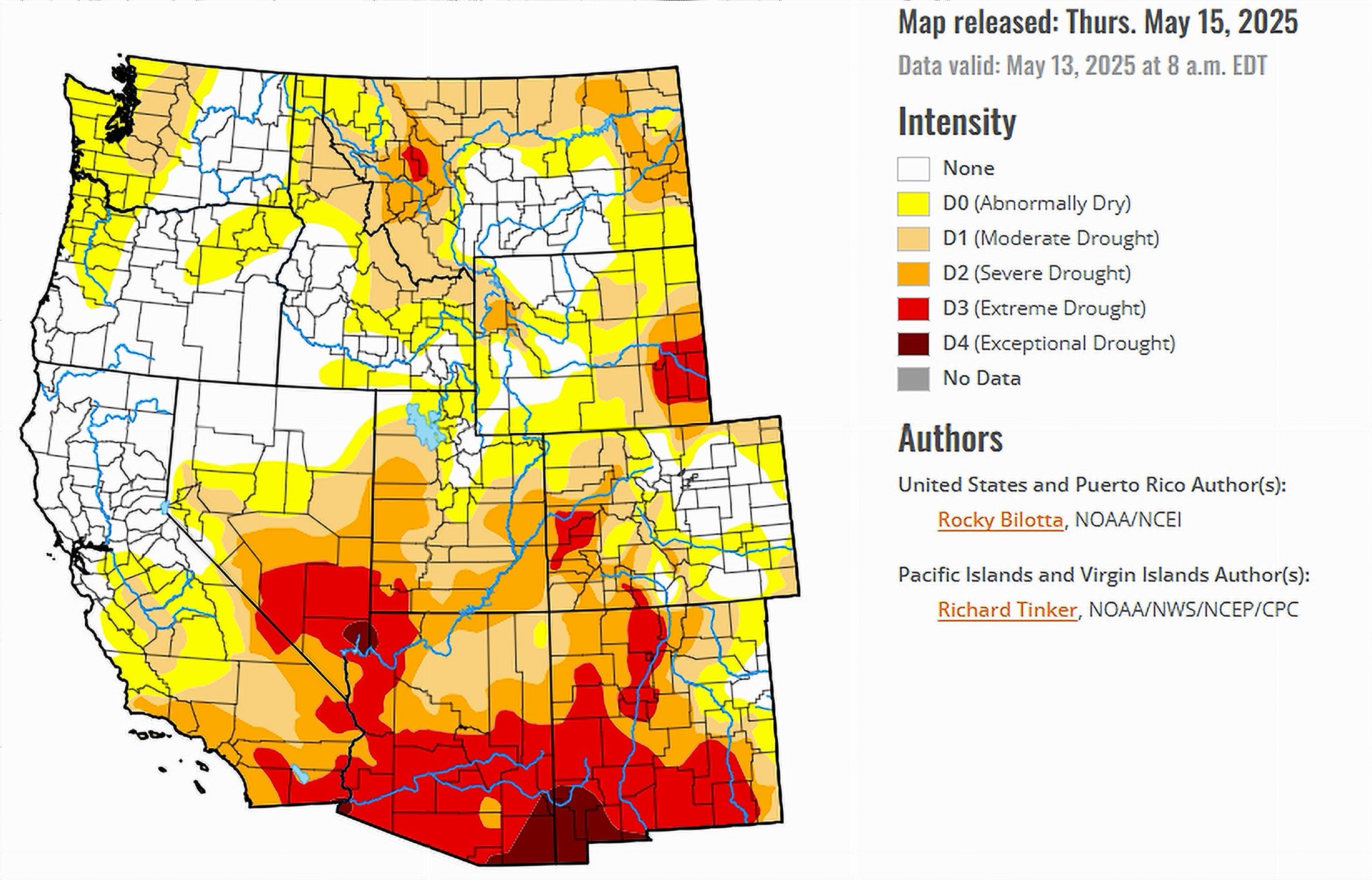- Dry conditions increased across the Southwest over the past week.
- 71.61% of the western U.S. is now experiencing drought or abnormal dryness.
- Arizona and Nevada saw modest relief; New Mexico worsened.
- Drought severity rose in parts of Utah, Colorado, and Wyoming.
Saturday, May 17, 2025 — The latest U.S. Drought Monitor released May 15, 2025 , shows a slight expansion in drought and abnormal dryness across the seven Colorado River Basin states. While Arizona and Nevada saw isolated improvements, new areas of drought emerged or intensified in Colorado, Utah, Wyoming, and New Mexico.
, shows a slight expansion in drought and abnormal dryness across the seven Colorado River Basin states. While Arizona and Nevada saw isolated improvements, new areas of drought emerged or intensified in Colorado, Utah, Wyoming, and New Mexico.
As of May 13—the data cutoff for this week’s report—71.61% of the western United States was classified as abnormally dry or worse, up from 68.79% the previous week. That includes conditions ranging from abnormal dryness (D0) to exceptional drought (D4). More significantly, 50.33% of the region is under moderate drought (D1) or worse, and 14.83% faces extreme to exceptional drought (D3–D4).
Arizona: Some Relief, But Core Dryness Persists.
Arizona saw improvement in areas along the Nevada border, where exceptional drought (D4) has now retreated. The Drought Monitor noted that “Exceptional drought (D4) was improved along the Nevada-Arizona border,” signaling temporary respite for a region that has faced persistent water stress. However, central and eastern Arizona continue to suffer under severe drought (D2) and extreme drought (D3) conditions, with limited short-term relief on the horizon.
noted that “Exceptional drought (D4) was improved along the Nevada-Arizona border,” signaling temporary respite for a region that has faced persistent water stress. However, central and eastern Arizona continue to suffer under severe drought (D2) and extreme drought (D3) conditions, with limited short-term relief on the horizon.
Nevada and California: A Southwest Contrast.
Southern Nevada mirrored Arizona’s modest improvements, while much of California remained dry. Parts of eastern California and southern Nevada saw extreme drought (D3) retreat slightly due to recent rainfall. But southern California, already experiencing abnormal dryness (D0), showed signs of deterioration. Above-normal temperatures and below-average precipitation in the north contributed to stagnant or worsening conditions across the state.
Colorado: Diverging Trends Across the State.
Colorado presented a divided picture. In the east, rainfall totals of 1 to 3 inches led to improvements in moderate to severe drought (D1–D2), especially near the Kansas border. However, western Colorado worsened, with extreme drought (D3) expanding due to continued dryness and declining soil moisture. This bifurcated pattern reflects the state’s transitional geography between the arid Southwest and the storm-fed High Plains.
Utah: North-South Split Continues.
Southern Utah improved marginally, with some relief from extreme drought (D3) conditions. However, the northern part of the state saw drought expand due to sustained precipitation deficits. As temperatures climbed, moderate drought (D1) intensified in several counties, leaving much of the state teetering between partial relief and renewed concern.
New Mexico: Worsening Drought in the South.
Southern New Mexico continued to deteriorate. The report highlighted the expansion of exceptional drought (D4) in this region, driven by a combination of dry weather, elevated temperatures, and poor soil moisture retention. These conditions come as agricultural producers brace for a difficult summer, with early heatwaves likely to stress already parched fields.
highlighted the expansion of exceptional drought (D4) in this region, driven by a combination of dry weather, elevated temperatures, and poor soil moisture retention. These conditions come as agricultural producers brace for a difficult summer, with early heatwaves likely to stress already parched fields.
Wyoming: Dryness Creeps In.
Southern and central Wyoming experienced a spread of abnormal dryness (D0) and moderate drought (D1). Although not yet severe, the new dryness is notable because Wyoming supplies key snowpack contributions to the Colorado River system. Dry conditions in late spring could hinder runoff and recharge in coming months.
What’s Ahead.
Looking forward, the Climate Prediction Center’s 6–10 day forecast (May 18–22) suggests above-average precipitation for much of the central and eastern U.S. However, parts of the West—including California, Nevada, and the Florida Peninsula—are likely to stay dry. Temperature forecasts indicate increased heat across the Southwest, which could accelerate soil drying and further strain water systems.
As the region moves toward summer, with water demand rising and snowpack runoff nearing its end, conditions across the Colorado River Basin remain precarious. Continued monitoring will be essential for resource managers and communities alike.

